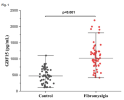Serum GDF15 as a supportive biomarker in female fibromyalgia patients based on a prospective case-control study
Ertugrul Yigit, Osman Cure, Merve Huner Yigit & Hakki Uzun
[Line breaks added]
Abstract
This study aimed to evaluate serum growth differentiation factor 15 (GDF15) as a potential supportive biomarker for fibromyalgia (FM) and investigate its association with disease severity. This prospective case-control study evaluated serum GDF15 levels in female fibromyalgia patients and healthy controls.
Participants were recruited from the Rheumatology Outpatient Clinic of Recep Tayyip Erdoğan University Hospital between May and September 2024. GDF15 concentrations were quantified by ELISA. Disease severity was assessed using the Revised Fibromyalgia Impact Questionnaire (FIQR), Widespread Pain Index (WPI), and Symptom Severity Score (SSS). Diagnostic accuracy was evaluated via ROC curve analysis.
We analyzed 120 women (FM n = 60; controls n = 60). Serum GDF15 levels were significantly higher in FM patients (median: 1022.33 pg/mL) than in healthy controls (473.08 pg/mL, p < 0.001). There were no significant differences in age or BMI between the FM and control groups (p > 0.05).
ROC analysis showed high diagnostic sensitivity (96.7%) and low specificity (53.3%) for GDF15 at a cutoff of 478.31 pg/mL (AUC = 0.922, 95% CI: 0.875–0.969, p < 0.001). Although GDF15 was markedly elevated in FM, no significant correlation was found between GDF15 levels and WPI, SSS, and FIQR scores (p > 0.05).
Serum GDF15 may serve as a supportive biomarker for FM; however, its limited specificity suggests it should complement—rather than replace—clinical assessment. Future studies should confirm its clinical utility and validate its role within multi-marker diagnostic panels.
Web | PDF | Scientific Reports | Open Access
---
Study found by @Nightsong
Ertugrul Yigit, Osman Cure, Merve Huner Yigit & Hakki Uzun
[Line breaks added]
Abstract
This study aimed to evaluate serum growth differentiation factor 15 (GDF15) as a potential supportive biomarker for fibromyalgia (FM) and investigate its association with disease severity. This prospective case-control study evaluated serum GDF15 levels in female fibromyalgia patients and healthy controls.
Participants were recruited from the Rheumatology Outpatient Clinic of Recep Tayyip Erdoğan University Hospital between May and September 2024. GDF15 concentrations were quantified by ELISA. Disease severity was assessed using the Revised Fibromyalgia Impact Questionnaire (FIQR), Widespread Pain Index (WPI), and Symptom Severity Score (SSS). Diagnostic accuracy was evaluated via ROC curve analysis.
We analyzed 120 women (FM n = 60; controls n = 60). Serum GDF15 levels were significantly higher in FM patients (median: 1022.33 pg/mL) than in healthy controls (473.08 pg/mL, p < 0.001). There were no significant differences in age or BMI between the FM and control groups (p > 0.05).
ROC analysis showed high diagnostic sensitivity (96.7%) and low specificity (53.3%) for GDF15 at a cutoff of 478.31 pg/mL (AUC = 0.922, 95% CI: 0.875–0.969, p < 0.001). Although GDF15 was markedly elevated in FM, no significant correlation was found between GDF15 levels and WPI, SSS, and FIQR scores (p > 0.05).
Serum GDF15 may serve as a supportive biomarker for FM; however, its limited specificity suggests it should complement—rather than replace—clinical assessment. Future studies should confirm its clinical utility and validate its role within multi-marker diagnostic panels.
Web | PDF | Scientific Reports | Open Access
---
Study found by @Nightsong
Last edited:

